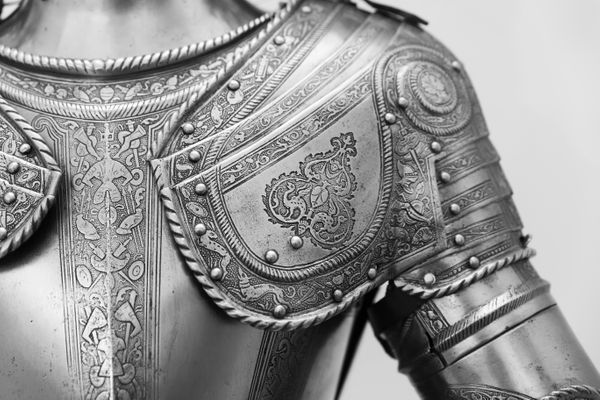2.1.1
Act 1, Scene 1
Key Events in Act 1, Scene 1
Key Events in Act 1, Scene 1
A tense and unsettling atmosphere fills the opening of Hamlet. This kind of atmosphere is typical of many crime texts.


The watchmen are introduced
The watchmen are introduced
- Two sentinels (watchmen), Barnardo and Francisco, keep watch atop Elsinore’s battlements in the middle of the night.
- The setting of the opening scene immediately creates a tense and uneasy atmosphere.
- The two watchmen are clearly on edge. The opening line (“Who’s there?”) immediately suggests mistrust and disquiet. Francisco is unable to make Barnardo out in the darkness.


Francisco introduces disease motif
Francisco introduces disease motif
- Francisco: “’Tis bitter cold / And I am sick at heart.”
- Francisco’s complaint introduces a motif of illness and disease. This motif will recur throughout the play.
- Shakespeare begins to create the sense of a sickness filling all of Denmark, although the cause of this is not yet known.
More Key Events in Act 1, Scene 1
More Key Events in Act 1, Scene 1
The two sentinels are relieved by Horatio and Marcellus. Together, they discuss “this thing” which has disturbed their watch on two previous nights. Just as Barnardo begins to recount the previous night’s events, the Ghost appears.


The Ghost first appears
The Ghost first appears
- The Ghost appears in the form of the dead King (old Hamlet), dressed in “the very armour” he wore when he vanquished the Norwegian and Polish armies.
- Horatio links this to the rumours of a Norwegian army led by the “hot” (hot-headed) young Fortinbras threatening Danish territory.


Horatio's description of the Ghost
Horatio's description of the Ghost
- Horatio: “This bodes some strange eruption to our state.”
- Horatio sees the Ghost’s visitation as a premonition of chaos and disorder within Denmark.
- The image of an “eruption” suggests possible violence and destruction. This term may also refer to boils or blisters breaking out on a person’s skin, continuing the motif of disease/sickness established earlier in the scene.


The Ghost vanishes
The Ghost vanishes
- The Ghost is about to speak. But, when the cock begins to crow, signalling the dawn of a new day, it vanishes. Horatio decides that they must inform young Hamlet of the Ghost’s visitation, believing that the “spirit… will speak to him.”
- Shakespeare builds suspense. The audience hopes for a future meeting with the Ghost, in which the reasons for its visitation will be revealed.


Horatio's description of the Ghost
Horatio's description of the Ghost
- Horatio on the Ghost's behaviour after the cock has crowed: “It started like a guilty thing / Upon a fearful summons.”
- Horatio’s description of the Ghost’s behaviour introduces the themes of guilt and punishment. These are common to most crime texts.


Introducing eternal punishment
Introducing eternal punishment
- Although the reasons for the Ghost’s possible guilt and punishment are not yet clear, Horatio and Marcellus speculate on the old belief that, as soon as a new day begins to break, the “erring spirit” must return to its “confine” (a place of confinement, such as a prison).
- This idea of eternal punishment in the afterlife will be developed by Hamlet later in the play. It is a crucial factor in delaying his revenge.
Key Ideas in Act 1, Scene 1 - The Supernatural
Key Ideas in Act 1, Scene 1 - The Supernatural
The supernatural is a key theme in Act 1, Scene 1.


Significance of the Ghost's entrance
Significance of the Ghost's entrance
- The Ghost's entrance is thought to be a premonition (or portent) of future disorder: Barnardo refers to the spirit as “portentous” while Horatio thinks that it might be an “omen”.
- The supernatural is therefore used to foreshadow potential chaos or turmoil where the natural world is turned upside down.


Reference to Caesar's death
Reference to Caesar's death
- Horatio links the Ghost’s visitation to the strange events that were said to occur in Rome before the assassination of Julius Caesar: “The graves stood tenantless and the sheeted dead / Did squeak and gibber in the Roman streets”.
- This reference to one of the most infamous crimes of the classical world - Caesar’s assassination - foreshadows old Hamlet’s murder.
1Introduction
2Plot Summary
2.1Act 1: Key Events & Ideas
2.2Act 2: Key Events & Ideas
2.3Act 3: Key Events & Ideas
2.4Act 4: Key Events & Ideas
2.5Act 5: Key Events & Ideas
3Character Profiles
3.1Hamlet
3.3Gertrude
3.4Ophelia
4Key Themes
4.1Regicide in Hamlet
4.2Madness in Hamlet
4.3Guilt & Punishment in Hamlet
4.4Settings in Hamlet
5Writing Techniques
6Context
6.1Social & Historical Context
6.2Literary Context
6.3Performance & Textual History
7Critical Debates
7.118-19th Century Responses to Hamlet
7.220th Century Responses to Hamlet
7.3Feminist Readings of Hamlet
7.4Marxist/Political Readings of Hamlet
Jump to other topics
1Introduction
2Plot Summary
2.1Act 1: Key Events & Ideas
2.2Act 2: Key Events & Ideas
2.3Act 3: Key Events & Ideas
2.4Act 4: Key Events & Ideas
2.5Act 5: Key Events & Ideas
3Character Profiles
3.1Hamlet
3.3Gertrude
3.4Ophelia
4Key Themes
4.1Regicide in Hamlet
4.2Madness in Hamlet
4.3Guilt & Punishment in Hamlet
4.4Settings in Hamlet
5Writing Techniques
6Context
6.1Social & Historical Context
6.2Literary Context
6.3Performance & Textual History
7Critical Debates
7.118-19th Century Responses to Hamlet
7.220th Century Responses to Hamlet
7.3Feminist Readings of Hamlet
7.4Marxist/Political Readings of Hamlet
Unlock your full potential with Seneca Premium
Unlimited access to 10,000+ open-ended exam questions
Mini-mock exams based on your study history
Unlock 800+ premium courses & e-books